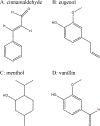Composition of aerosols from thermal degradation of flavors used in ENDS and tobacco products
- PMID: 35913821
- PMCID: PMC9830633
- DOI: 10.1080/08958378.2022.2103602
Composition of aerosols from thermal degradation of flavors used in ENDS and tobacco products
Abstract
Aim: The cardiovascular toxicity of unheated and heated flavorants and their products as commonly present in electronic cigarette liquids (e-liquids) was evaluated previously in vitro. Based on the results of in vitro assays, cinnamaldehyde, eugenol, menthol, and vanillin were selected to conduct a detailed chemical analysis of the aerosol generated following heating of each compound both at 250 and 750 °C. Materials and Methods: Each flavoring was heated in a drop-tube furnace within a quartz tube. The combustion atmosphere was captured using different methods to enable analysis of 308 formed compounds. Volatile organic compounds (VOCs) were captured with an evacuated Summa canister and assayed via gas chromatography interfaced with mass spectrometry (GC-MS). Carbonyls (aldehydes and ketones) were captured using a 2,4-dinitrophenylhydrazine (DNPH) cartridge and assayed via a high-performance liquid chromatography-ultra-violet (HPLC-UV) assay. Polyaromatic hydrocarbons (PAHs) were captured using an XAD cartridge and filter, and extracts were assayed using GC-MS/MS. Polar compounds were assayed after derivatization of the XAD/filter extracts and analyzed via GC-MS. Conclusion: At higher temperature, both cinnamaldehyde and menthol combustion significantly increased formaldehyde and acetaldehyde levels. At higher temperature, cinnamaldehyde, eugenol, and menthol resulted in increased benzene concentrations. At low temperature, all four compounds led to higher levels of benzoic acid. These data show that products of thermal degradation of common flavorant compounds vary by flavorant and by temperature and include a wide variety of harmful and potentially harmful constituents (HPHCs).
Keywords: Cinnamaldehyde; ENDS; eugenol; menthol; tobacco; vanillin.
Figures





Similar articles
-
Effects of Common e-Liquid Flavorants and Added Nicotine on Toxicant Formation during Vaping Analyzed by 1H NMR Spectroscopy.Chem Res Toxicol. 2022 Jul 18;35(7):1267-1276. doi: 10.1021/acs.chemrestox.2c00110. Epub 2022 Jun 23. Chem Res Toxicol. 2022. PMID: 35735356 Free PMC article.
-
An evaluation of electronic cigarette formulations and aerosols for harmful and potentially harmful constituents (HPHCs) typically derived from combustion.Regul Toxicol Pharmacol. 2018 Jun;95:153-160. doi: 10.1016/j.yrtph.2018.03.012. Epub 2018 Mar 20. Regul Toxicol Pharmacol. 2018. PMID: 29567331
-
Carbonyl emissions from a novel heated tobacco product (IQOS): comparison with an e-cigarette and a tobacco cigarette.Addiction. 2018 Nov;113(11):2099-2106. doi: 10.1111/add.14365. Epub 2018 Jul 10. Addiction. 2018. PMID: 29920842
-
Carbonyl compounds generated from electronic cigarettes.Int J Environ Res Public Health. 2014 Oct 28;11(11):11192-200. doi: 10.3390/ijerph111111192. Int J Environ Res Public Health. 2014. PMID: 25353061 Free PMC article. Review.
-
Electronic nicotine delivery system design and aerosol toxicants: A systematic review.PLoS One. 2020 Jun 4;15(6):e0234189. doi: 10.1371/journal.pone.0234189. eCollection 2020. PLoS One. 2020. PMID: 32497139 Free PMC article.
Cited by
-
The Smoky Impact of Nicotinic Acetylcholine Receptors on Testicular Function.J Clin Med. 2024 Aug 28;13(17):5097. doi: 10.3390/jcm13175097. J Clin Med. 2024. PMID: 39274310 Free PMC article. Review.
-
A Review of the Toxicity of Ingredients in e-Cigarettes, Including Those Ingredients Having the FDA's "Generally Recognized as Safe (GRAS)" Regulatory Status for Use in Food.Nicotine Tob Res. 2024 Oct 22;26(11):1445-1454. doi: 10.1093/ntr/ntae123. Nicotine Tob Res. 2024. PMID: 38783714 Free PMC article. Review.
-
Carbonyl Profiles of Electronic Nicotine Delivery System (ENDS) Aerosols Reflect Both the Chemical Composition and the Numbers of E-Liquid Ingredients-Focus on the In Vitro Toxicity of Strawberry and Vanilla Flavors.Int J Environ Res Public Health. 2022 Dec 14;19(24):16774. doi: 10.3390/ijerph192416774. Int J Environ Res Public Health. 2022. PMID: 36554655 Free PMC article.
-
Addressing Cardiovascular Toxicity Risk of Electronic Nicotine Delivery Systems in the Twenty-First Century: "What Are the Tools Needed for the Job?" and "Do We Have Them?".Cardiovasc Toxicol. 2024 May;24(5):435-471. doi: 10.1007/s12012-024-09850-9. Epub 2024 Mar 31. Cardiovasc Toxicol. 2024. PMID: 38555547 Free PMC article. Review.
-
Via entropy analysis (EA) and systematic cluster analysis (SCA), multi-index chemometric analysis of 20 amino acids, trace elements, etc., of five green teas from Guizhou, China.BMC Chem. 2025 Jul 21;19(1):217. doi: 10.1186/s13065-025-01588-x. BMC Chem. 2025. PMID: 40691580 Free PMC article.
References
-
- Lampman GM, Andrews J, Bratz Wayne. Preparation of vanillin from eugenol and sawdust. J Chem Educ. 1977, 54, 12,776
-
- Bhuiyan MNI, Begum J, & Akter F (2010). Constituents of the essential oil from leaves and buds of clove (Syzigium caryophyllatum (L.) Alston). African Journal of Plant Science, 4(11), 451–454.
-
- Clapp PW, Lavrich KS, van Heusden CA, Lazarowski ER, Carson JL, Jasper I 2019. Cinnamaldehyde in flavored e-cigarette liquids temporarily suppressesbronchial epithelial cell ciliary motility by dysregulation of mitochondrialfunction. Am J Physiol Lung Cell Mol Physiol. 316, L470–L486. - PMC - PubMed
Publication types
MeSH terms
Substances
Grants and funding
LinkOut - more resources
Full Text Sources
Other Literature Sources
Medical
Miscellaneous
